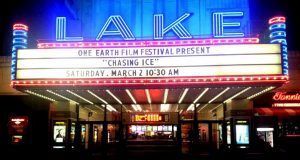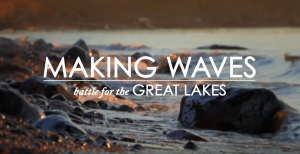
Films as a “catalyst for discourse”
In 2012 with an approaching Earth Day top of mind, Green activist Ana Garcia-Doyle was looking for a way her environmental network could stop “just talking to ourselves.”

Ana Garcia Doyle, One Earth Film Festival Director and founding Member , courtesy of oneearthfilmfest.org
She wanted to “shake things up” and take an environmental message beyond the progressive bubble of her community that borders Chicago’s West Side.
A year earlier based on a personal interest, Garcia-Doyle researched Washington, D.C.’s long-running environmental film festival.
Impressed by what she saw, she pitched the film fest idea to colleagues at Green Community Connections, her local Green group. Garcia-Doyle told Great Lakes Now that three people were “onboard right away and it took a little more convincing” for others to buy in.
Seven weeks later One Earth Film Festival launched and drew 500 people over the course of a weekend.
In 2017, the festival attracted more than 5,000 viewers at 43 locations in Greater Chicago. It now bills itself as the “Midwest’s premier environmental film festival,” a claim Garcia-Doyle proudly defended when challenged to justify the claim by Great Lakes Now.
“Catalyst for discourse”
The goal of the festival isn’t to advocate on the various environmental issues according to Garcia-Doyle. She says people are attending a film and it’s supposed to be easy with no petitions to sign or pledges to make.
The goal is to serve as a “catalyst for discourse” and to get film viewers to “reflect on this and connect with this and figure out what is their part.”

One Earth Film Festival Marquee, courtesy of oneearthfilmfest.org
“We’re giving people options and opportunities and asking them to choose” if and how they will get involved on the issues, she said.
As the festival expanded, it has reached areas distant from Chicago that have a different socio-political makeup from the festival’s progressive urban roots.
But Garcia-Doyle said that hasn’t been a barrier to local engagement.
She said when the festival went to Kane County bordering on corn country west of Chicago, the reception was better than in some of the progressive communities where it sometimes took a while for the locals to engage.
People in Kane County hit the ground running and were focused on local issues, according to Garcia-Doyle.
‘They’re very concerned about their watershed and they’re concerned about farming and agriculture in their communities,” and there was a lot that festival organizers could learn from their rural colleagues, she said.
Trump bump
Garcia-Doyle told Great Lakes Now the festival experienced a “Trump bump” of increased interest last year based on concern over President Donald Trump’s rollback of environmental protections.
“People are coalescing with a sense of urgency and a sense of agency” that they can do something to push back on Trump’s environmental agenda, according to Garcia-Doyle.
She said the festival has experienced a noticeable increase in the number of volunteers since Trump’s election.

Making Waves Battle for the Great Lakes, courtesy of Great Lakes Media
The 2018 festival includes two films with Great Lakes implications.
Making Waves: Battle for the Great Lakes, chronicles the ascent and consequences of aquatic invasive species on the Great Lakes ecosystem and economy.
Straws, puts a spotlight on the 500 million one-use plastic straws that are tossed every day by Americans, many of which end up in waterways. The Great Lakes receive 22 million pounds of plastic refuse annually.
Other film topics include environmental justice, fracking and clean energy.
The One Earth Film Festival runs through March 10th.
Editor’s note: Great Lakes Now’s Gary Wilson has been a guest panelist at previous One Earth Film Festivals. He is moderating post-film discussion of the film Making Waves: Battle for the Great Lakes,this year.




